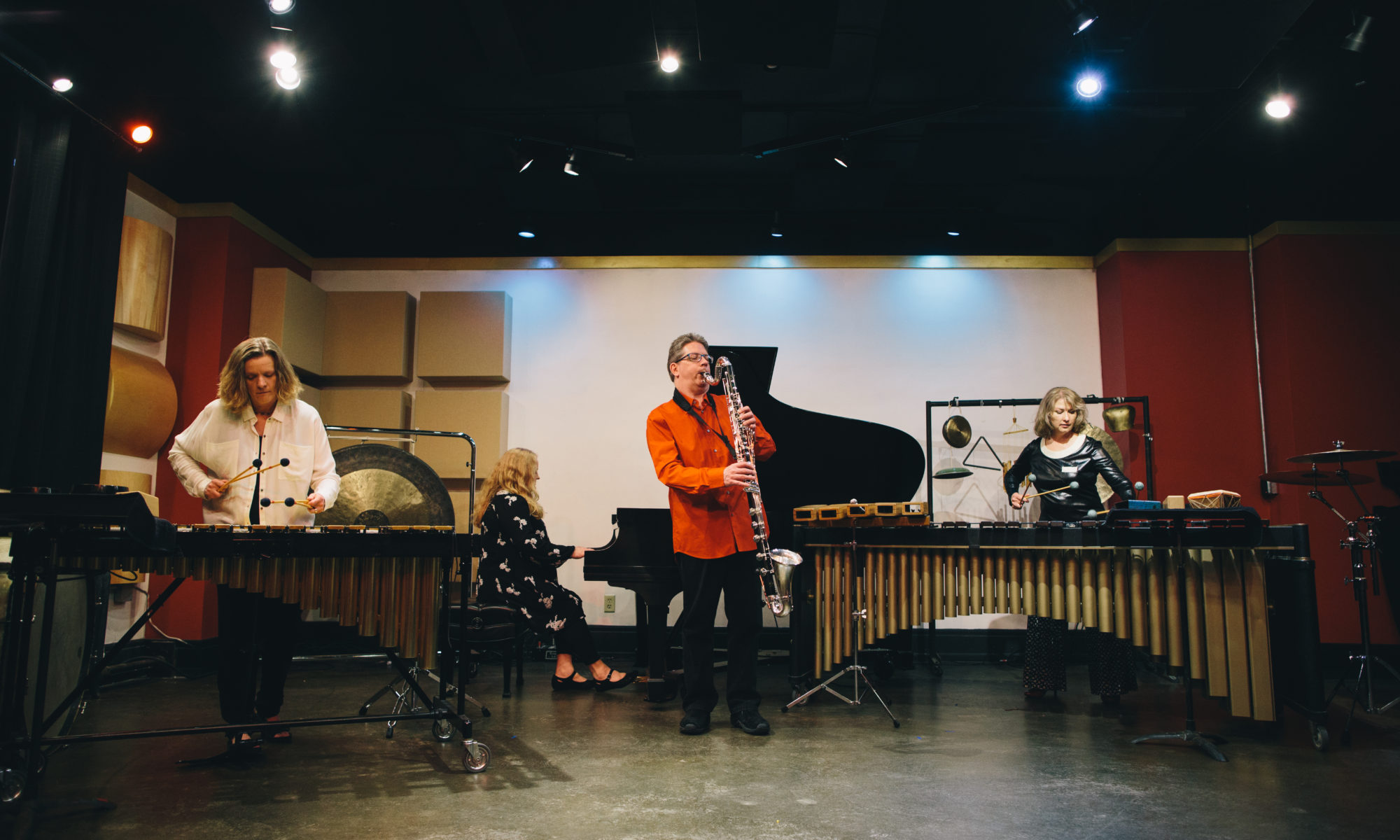Mikrophonie I (1964) by Karlheinz Stockhausen
Performed by Zeitgeist: Heather Barringer, Pat O’Keefe, Patti Cudd, and Nicola Melville
with Mike Duffy and Brett Wartchow, electronics
Produced by Andrew Rindfleisch
“After finishing the score of MIXTUR for orchestra and ring modulators, I searched for ways to compose – flexibly – also the process of microphone recording. The microphone, used until now as a rigid, passive recording device to reproduce sounds as faithfully as possible, would have to be come a musical instrument and, through its manipulation, influence all the characteristics of the sounds. In other words, it would have to participate in forming the pitches – according to composed indications – harmonically and melodically, as well as the rhythm, dynamic level, timbre and spatial projection of the sounds.
In 1961, I had purchased a large tam-tam for the composition MOMENTE and set it up on the balcony and later in the garden. Time and again I would make experiments in which I excited the tam-tam using a great variety of implements – of glass, cardboard, metal, wood, rubber, plastic – which I had collected from around the house. One day I took some equipment from the WDR Studio for Electronic Music home with me. My collaborator Jaap Spek helped me. I played on the tam-tam with every possible utensil and during this, moved the microphone above the surface of the tam-tam. The microphone was connected to an electrical filter whose out put was connected to a volume control (potentiometer), and this in turn, was connected to amplifier and loudspeaker. During this, Jaap Spek changed the filter settings and dynamic levels, improvising. At the same time, we recorded the result on tape. This work was the genesis of a live electronic music with unconventional music instruments.
On the basis of this experiment I wrote the score of MIKROPHONIE I. Two players excite the tam-tam using a great variety of implements, two further players scan the tam-tam with microphones; and an appropriate notation prescribes the distance between the microphone and the tam-tam, the relative distance of the microphone from the point of excitation, and the rhythm of the movements of the microphone. Two further players– seated in the auditorium–each operate an electrical filter and two potentiometers. They, in turn, reshape the timbre and pitch, dynamic level, spatial effect, and the rhythm of the structures. In this way three mutually dependent, mutually interacting and simultaneously autonomous processes of sound-structuring are connected with each other. These were composed to be synchronous or temporally independent, homophonic or polyphonic layers.”
—Karlheinz Stockhausen

Karlheinz Stockhausen (1928–2007) started composing in the early 1950s. Already the first compositions of “Point Music” such as KREUZSPIEL (CROSS-PLAY) in 1951, SPIEL (PLAY) for orchestra in 1952, and KONTRA-PUNKTE (COUNTER-POINTS) in 1952/53, brought Stockhausen international fame. Fundamental achievements in music since 1950 are indelibly imprinted through his compositions: The “Serial Music”, the “Point Music”, the “Electronic Music”, the “New Percussion Music”, the “Variable Music”, the “New Piano Music”, the “Space Music”, “Statistical Music”, “Aleatoric Music”, “Live Electronic Music”; new syntheses of “Music and Speech”, of a “Musical Theatre”, of a “Ritual Music”, “Scenic Music”; the “Group Composition”, polyphonic “Process Composition”, ” Moment Composition”, “Formula Composition” to “Multi-Formula Composition”; the integration of “found objects” (national anthems, folklore of all countries, short-wave events, “sound scenes”, etc.) into a “World Music” and a “Universal Music”; the synthesis of European, African, Latin American and Asian music into a “Telemusic”; the vertical ” Octophonic Music”.
Stockhausen’s entire oeuvre can be classified as “Spiritual Music”; this becomes more and more evident not only in the compositions with spiritual texts, but also in the other works of “Overtone Music”, “Intuitive Music”, “Mantric Music”, reaching “Cosmic Music” such as STIMMUNG (TUNING), AUS DEN SIEBEN TAGEN (FROM THE SEVEN DAYS), MANTRA, STERNKLANG (STAR SOUND), INORI, ATMEN GIBT DAS LEBEN (BREATHING GIVES LIFE), SIRIUS, LICHT (LIGHT), KLANG (SOUND).
From 1977 to 2003 he composed the cycle of operas LICHT (LIGHT), The Seven Days of the Week, which comprises about 29 hours of music. All of the seven parts of this music-theatre work have had their staged world premières: DONNERSTAG (THURSDAY) in 1981, SAMSTAG (SATURDAY) in 1984, and MONTAG (MONDAY) in 1988, all three produced by the Teatro alla Scala in Milan; DIENSTAG (TUESDAY) in 1993 and FREITAG (FRIDAY) in 1996, both at the Leipzig Opera, SONNTAG (SUNDAY) in 2011, at the Cologne Opera. With MITTWOCH (WEDNESDAY), the Birmingham Opera Company presented the last day of the LICHT heptalogy on Wednesday, August 22nd 2012. After LICHT, Stockhausen intended to compose the hours of the day, the minute and the second. He began the cycle KLANG (SOUND), The 24 Hours of the Day, and until his death in December 2007, he composed the 1st Hour HIMMELFAHRT (ASCENSION) to the 21st Hour PARADIES (PARADISE).


